
Researchers from the University of Illinois Urbana-Champaign studying mouse models of Alzheimer’s disease (AD) have found the earliest biomarker of the disease to date. The biomarker, a neural-specific protein in the brain, exhibits increased activity that leads to seizures associated with the earliest stages of neurodegeneration.
Reporting Wednesday in EMBO Reports, study leader Nien-Pei Tsai, PhD, a professor of molecular and integrative physiology, says that the protein PSD-95 is a promising new target for early diagnosis and treatment as inhibiting it in mice slowed the onset and progression of seizures.
The research of Tsai and team stands out as they focused on a time frame in AD development that is much earlier in the lifespan of the AD mouse models, well before other biomarkers or abnormalities have been noted.
“We were thinking, if we can catch anything that is happening early enough, maybe we can find a way to diagnose the disease earlier or slow down the progression,” Tsai said. “We know that Alzheimer’s is irreversible. But if we can slow down the progression or even delay the onset of the disease, we can improve the quality of life for patients.”
The investigator’s study of early neural development began in neuron cells cultures and progressed to live mice and revealed an elevation of the PSD-95 protein. PSD-95’s main task in the brain is to attract and pull other receptors to the synaptic surface to foster synaptic activity. Tsai said the research has revealed that elevated levels of PSD-25 contribute to hyperexcitability in the brain, a common and recognized phenotype of patients in the earliest stages of AD development. This heightened activity and greater risk of seizure precedes and often exacerbates the ensuing neurodegeneration of advancing AD.
To confirm their suspicions on the role of PSD-95 in seizures related to Alzheimer’s development, the research team inhibited PSD-95 expression in one mouse cohort and saw reduced receptor activity at synapses, fewer seizures, and reduced seizure-related mortality.
“Our findings show that PSD-95 is a critical contributor to the hyperexcitability in the earliest stages of Alzheimer’s. So, we think that PSD-95 can be an early biomarker to indicate that a patient could have Alzheimer’s disease or elevated seizure susceptibility,” Tsai concluded. “In terms of treatment, antibody inhibitors for PSD-95 could be useful in the early onset of Alzheimer’s, with more clinical study.”
The next steps for the Urbana-Champaign researchers include finding clinical research teams they can partner with to determine whether this discovery in mouse models will correlate with human samples. The team also intends to study the interaction of PSD-95 with other receptors on the synaptic surface to find whether it plays a part in other symptoms of AD or other stages of progression.













